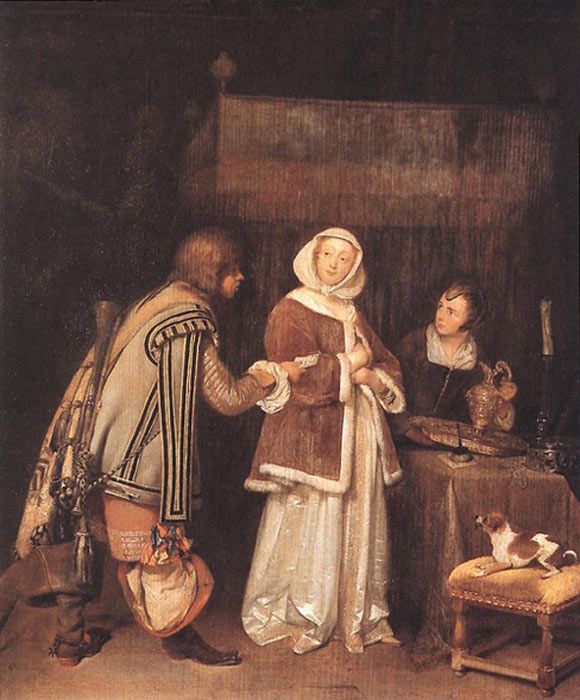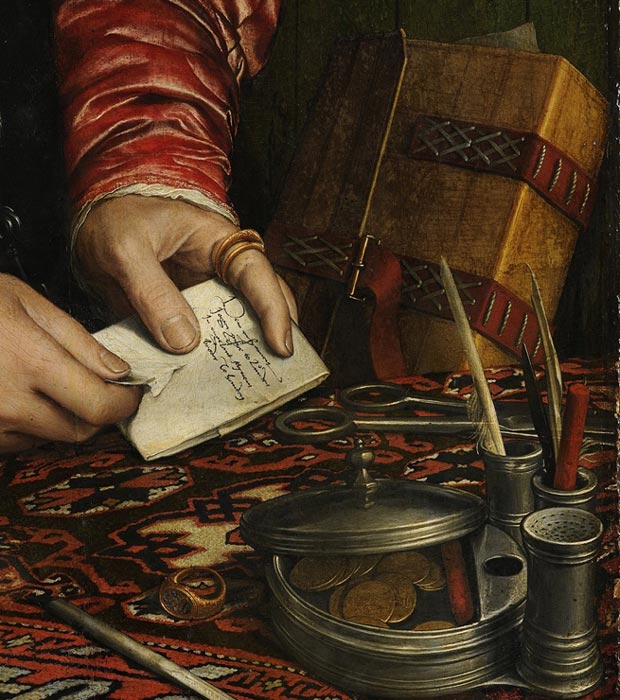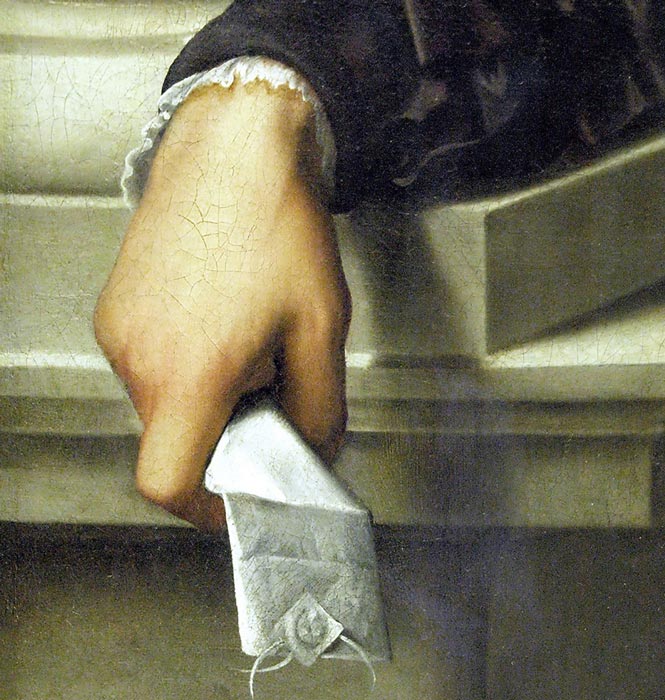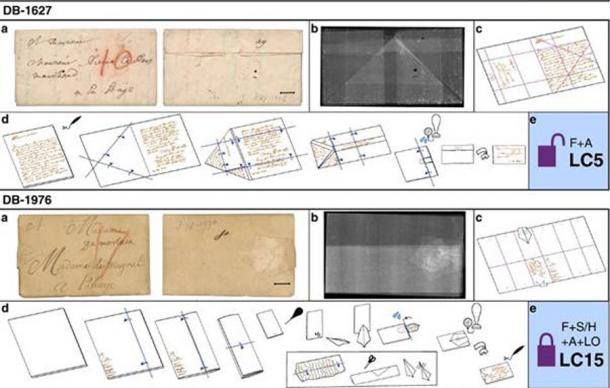
Securing Ancient Secrets: The Fascinating History of Letterlocking
Communication through written word existed long before the days of text messages and DMs, and even then some kind of security was needed to protect people’s secrets. When we think of a handwritten letter nowadays, we think of a neatly folded piece of paper inserted into a pristine white envelope and sealed with a lick or two. However, this was not always the case for letters. For centuries, before the invention of envelopes, those sending letters used a craft known as letterlocking to secure their handwritten notes before sending them on their way.

The Rejected Letter by Gerard ter Borch. (Public domain)
But, What Exactly is Letterlocking?
Letterlocking is the art of using specific folds and cuts in flexible paper to seal it shut for document security. Because paper was not always as common as it is today, it was much more expensive, which led to minimizing the use of paper as much as possible. At this point in history, envelopes would have been seen as excess cost, an issue that was quickly solved with letterlocking.
- Signed, Sealed, and Undelivered: Letters in Trunk Reveal Scandals and Intrigues of 17th Century Lives
- Secret Letters, Including 400-Year-Old Shopping List, Found in Historic Mansion in England
By being able to cut, fold, and seal a letter without using excess paper, senders saved money while still ensuring their message would not be intercepted. And if it was, there would be clear evidence of tampering that would be recognized by the recipient. This significantly deterred curious eyes due to fear of being caught by the recipient, which would destroy the reputation and credibility of the deliverer.
There were many different ways individuals could lock their letters using this method. Before we delve deeper, we’ll first take a look at how long letterlocking was practiced and some of the significant uses of letterlocking throughout letter-writing history.

Brienne trunk: a seventeenth-century trunk of letters, now known as the Brienne Collection, bequeathed to the Dutch postal museum in The Hague. (Unlocking History Research Group)
Before Encryption, There Was Letterlocking
Letterlocking as a form of document security only recently began to be studied in the early 2000s, when conservator Jana Dambrogio was allowed to be the first outside woman to have access to the Vatican Secret Archives in Italy. As she looked through the archives, she came across hundreds of different letters and legal documents from as early as the 1400s, all of which had something in common. Though some may have seen the various folds and tucks and assumed they were wrinkles or damage from the passage of time, Dambrogio recognized these as a form of ancient letter folding.
After discovering these fascinating letters, she returned to her home lab at MIT in Massachusetts, where she worked alongside her team to hunt for more ancient letterlocked documents. They were successful in finding some small collections in museum archives across the US, but their biggest discovery occurred just a few years ago when they came across an entire trunk of over 2,600 undelivered letters from 1600s Europe, 577 of which were still unopened. Now called the Brienne Collection, it belonged to a postmaster and postmistress couple in the Netherlands who had been unable to deliver them due to death or financial strain of the intended recipient, since it was the recipient of letters who had to pay for them in the 17th century.
Document Security
According to Dambrogio’s research, letterlocking has origins sometime around the 1200s in Europe, when flexible writing paper became the norm. Designed to “lock” letters shut, it was an early and cost-efficient way of sealing messages away from curious eyes and keeping the message intact for its recipient. There were many reasons why letterlocking became so essential – whether it was a diplomatic letter, a military plan, or a message from a spy, a letter getting into the wrong hands could mean danger for more than one person. It would also alert the recipient to a message potentially being compromised, as letterlocking would show evidence of tampering if seals were broken.
Soon, it became normal for all letters to be letterlocked in some way. It was a way to keep love letters intimate and letters to family or friends private from nosy bodies. Though less important messages may have still been sent off with simple folding, important documents or letters with private messages were always letterlocked for safety and privacy.
Beyond privacy, letterlocking was also considered an art form. With so many complex folds and cuts, creating detailed locks took time and effort, which didn’t go unnoticed by recipients. Some individuals were even known by their signature letterlocking techniques, such as Jane Whorwood, a Royalist agent during the English Civil War. Her letterlocking technique was so unique that King Charles I of England once noted that he always knew when a letter was from her simply from “the foldings.”

Detail of letter created using letterlocking from a painting of The Merchant Georg Gisze, by Hand Holbein the Younger. (Public domain)
Pretty and Private: Methods of Letterlocking
Evidence of letterlocking is scarce from the 13th and 14th centuries, but more can be found from the 15th century on. One of the most popular individuals who used letterlocking was Mary Queen of Scots, who frequently utilized letterlocking to protect important diplomatic messages. As she sat in prison the night before her execution, she wrote her final letter to her brother-in-law, King of France Henry III, and famously sealed it using a complex letterlocking technique. Mary cut a long, thin portion of the letter paper on the side, cut holes in the letter itself, and used the slip to bind the letter. The recipient would have to tear the wrap to open the letter, meaning any tampering would be immediately obvious.
The method used by Mary is called the “spiral lock,” in which the writer would weave the sliver of paper through slots created in the pages before being wet with a few drops of water. This would let the fibers in the paper swell to create an initial “lock.” Then, the leftover end would sometimes be fully sealed with a drop of paste or wax. The spiral lock was famous amongst English dignitaries at the time, and was also used by Mary’s cousin, Queen Elizabeth I.
Even more complex methods were used by other diplomats, such as Scottish diplomat William Keith of Delney, who was stationed in Italy and frequently used letters to communicate with King James VI of Scotland. Reportedly, his letterlocking was so complex that the entire letter would be torn to pieces if not opened properly and carefully. This was reportedly a source of amusement for him.

Detail from Portrait de Melchior von Brauweiler by Jan Stephan van Calcar, showing a folded paper letter circa 1540. (takomabibelot / CC BY 2.0)
The triangle lock was one of the most common locks used in Europe and England between the 15th and 18th centuries. The fold requires you to cut a triangle off the bottom of the letter, fold the letter in half, and then thread the triangle through a slit you make in the center of the folded letter. Then, the triangle is folded as a lock and sealed with glue or wax. This was one of the simplest methods besides scrolls to seal letters and keep messages hidden.
According to historians, there are at least 16 identifiable letterlocking formats, ranging from scrolls and triangles to dodecagons. The more complex the fold, the more time it takes to seal, and the more time it takes the recipient to carefully unfold it without damaging it. If you’ve ever done origami, you know just how tender folding and unfolding a simple piece of paper can be.
One of the historically most complex and complicated letterlocking techniques was dubbed the “dagger trap,” which was seen in a 1601 British intelligence letter from Italy. The dagger trap had a secret internal flap woven into the folds and sealed with wax, which was essentially a paper “booby trap.” The letter was then also sewn shut with thread, resulting in the recipient having to cut the string and then carefully pry open the flap to open the letter. Any attempts to intercept and read the highly-protected letter would result in the tearing of the “booby trap” flap, which would reveal it had been tampered with.
Nowadays, technology has advanced so far that historians don’t even need to risk breaking seals of letters to determine which fold they are. Conservators are able to virtually read ancient unopened letters using X-rays and building a 3D image of the unfolded version. This keeps artifacts intact while still giving us the ability to read messages and interpret how they relate to historical cultures and politics. Researchers have analyzed over 250,000 letters digitally, with the oldest being a letter dated on the 31st of July, 1697. The letter was from a French merchant named Jacques Sennacques and written to his cousin, Pierre Le Pers, and was one of the 2,600 undelivered letters from the Brienne Collection.

Two examples of letters created using letterlocking from the Brienne Collection. (Dambrogio et. al. / CC BY 4.0)
The Envelope: Letterlocking’s Demise
Though letterlocking was effective for many years, it was tedious and took a significant amount of time to complete without accidentally damaging the letter or breaking the seal. As time passed, paper became easier to produce and therefore ended up becoming much more affordable. With paper now being so cheap, alternative methods for sealing private documents began developing. Various paper wrappings using gum as a sealant were created, which eventually led to the modern-day envelope.
- Archaeologists Uncover Spine-tingling New Hoard of Roman Letters at Vindolanda Fort
- Sealed Letter Virtually Unfolded to Reveal Forgotten Renaissance Story
Once envelopes were able to be mass-produced using machines, letterlocking experienced a slow but sure death. Being cheaper and easier than letterlocking, the negligible cost of envelopes meant that they quickly won the battle for best method of mailed document security.
Though we don’t use letterlocking anymore, some old-fashioned ways of sealing letters still exist and this ancient tradition has even made recent comebacks. Methods such as wax seals are increasingly popular for sealing invitations to weddings and other special events. Others continue to use stylish folding for added aesthetics on some paper documents. Though it is not the norm anymore, letterlocking certainly still exists to an extent worldwide. So, the next time you mail a letter, think about the tedious yet beautiful art of letterlocking, and consider yourself lucky that now all you need to do is lick and stick.
Top image: Researchers generated a virtual sequence to unfold a sealed letter protected via letterlocking. Source: Unlocking History Research Group / CC BY 4.0
By Lex Leigh
References
Akkerman, N. 2020. Invisible Agents: Women and Espionage in Seventeenth-Century Britain. Oxford University Press.
Cain, A. 2 June 2021. “Deter prying eyes by locking your own letters” in Atlas Obscura. Available at: https://www.atlasobscura.com/articles/letterlocking-how-to
Dambrogio, J. 2021. “Unlocking history through automated virtual unfolding of sealed documents imaged by X-ray microtomography” in Nature Communications. Available at: https://www.nature.com/articles/s41467-021-21326-w
Denny, H. 23 April 2014. “The art and science of letterlocking” in MIT News. Available at: https://news.mit.edu/2014/art-and-science-letterlocking
Fisher, R. 18 2021, June 18. “The clever folds that kept letters secret” in BBC Future. Available at: https://www.bbc.com/future/article/20210616-how-the-forgotten-tricks-of-letterlocking-shaped-history
Flood, A. 10 December 2021. “Mary, queen of Scots 'locked' final letter using paper-folding, research finds” in The Guardian. Available at: https://www.theguardian.com/books/2021/dec/10/mary-queen-of-scots-locked-final-letter-using-paper-folding-research-finds
Flood, A. 2 March 2021. “Researchers read sealed 17th century letter without opening it” in The Guardian. Available at: https://www.theguardian.com/books/2021/mar/02/researchers-read-sealed-17th-century-letter-without-opening-virtual-unfolding-x-ray
Kernan, M. 1 October 1997. “Pushing the envelope” in Smithsonian Magazine. Available at: https://www.smithsonianmag.com/history/pushing-the-envelope-144581278/
Marshall, C. 14 November 2018. “The art of letterlocking: The elaborate folding techniques that ensured the privacy of handwritten letters centuries ago” in Open Culture. Available at: https://www.openculture.com/2018/11/the-art-of-letterlocking.html















